Menu
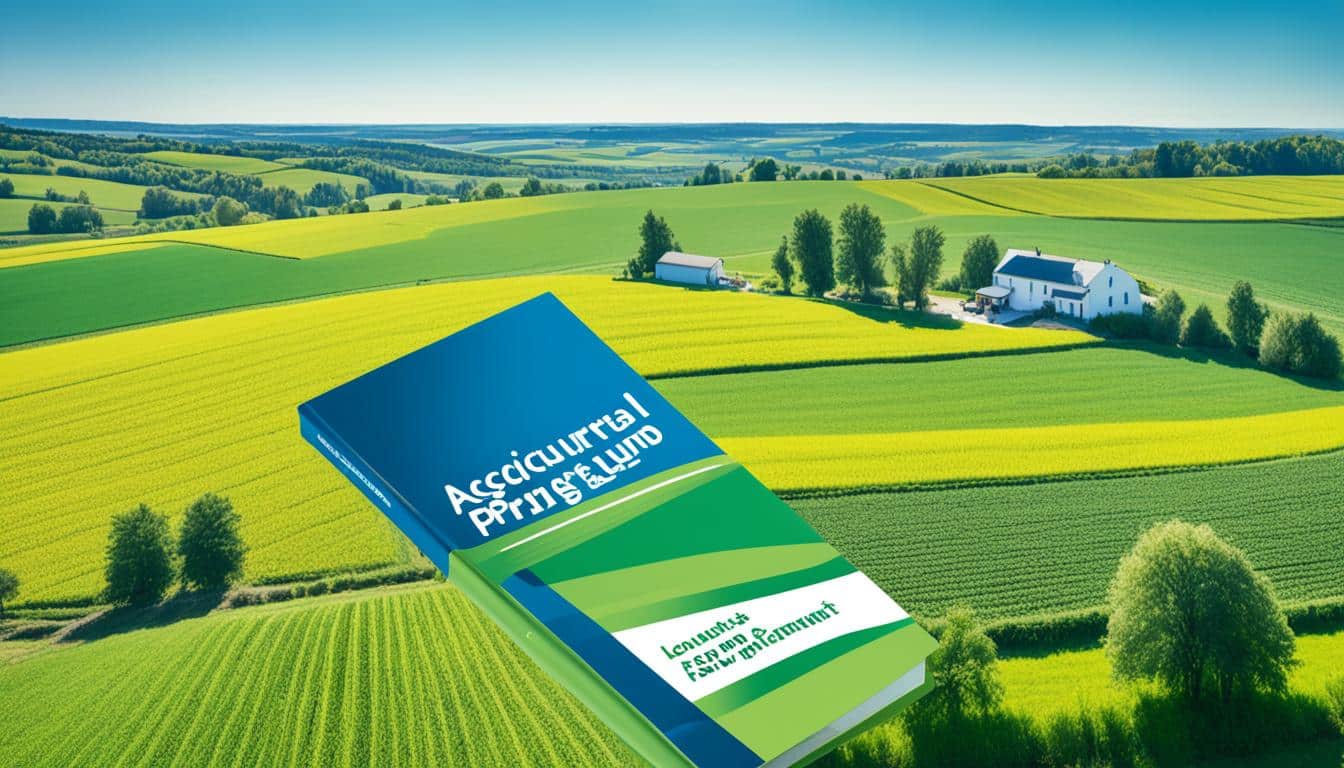
Did you know that over 26,000 farmers seek a Direct Loan from the Farm Service Agency (FSA) every year? The FSA helps around 85,000 borrowers with Direct Loans. This shows how essential these loan programs are for U.S. farmers and ranchers.
The FSA offers many loan programs to support agriculture’s future. Zach Ducheneaux, the FSA Administrator, says these loans help farmers improve their work. They also help take care of our planet.
Farmers can use these loans for various needs. This includes buying new technology or changing how they farm to protect the environment. The U.S. Department of Agriculture (USDA) wants to help farms grow and use new ideas. This includes making sure everyone playing fair in the farming business.
U.S. Agricultural Loan Programs are key in boosting farming businesses with various loan types. These schemes help farmers get the funds they need. This way, they can try new farming methods and grow their farms. The Farm Service Agency (FSA) runs these programs, offering loans for different needs, like buying land or daily farming costs. There are even small loans for unique projects.
These loans are big on helping farms use less energy and water. They also focus on trapping carbon. Farmers use the money to try eco-friendly ways like planting certain crops, buying high-tech farming tools, and using special ploughing methods. These steps make farming more efficient and good for the planet.
| Loan Type | Interest Rate |
|---|---|
| Farm Operating – Direct | 5.250% |
| Farm Operating – Microloan | 5.250% |
| Farm Ownership – Direct | 5.500% |
| Farm Ownership – Microloan | 5.500% |
| Farm Ownership – Direct, Joint Financing | 3.500% |
| Farm Ownership – Down Payment | 1.500% |
| Emergency Loan – Amount of Actual Loss | 3.750% |
Farmers have to understand their loan options for profitable and green farming practices. Each loan serves a unique purpose. This makes it easier for many farmers to get support. It’s all about helping the farm world move forward with smart money choices.
The USDA Farm Service Agency has loans that fit different farmer needs. These loans help with buying land, running the farm, or starting a new project. I will explain each loan to help you understand the options available.
Direct loans at a 5.500% interest rate are available for buying or expanding farms. They go up to $600,000 and back green practices. New farmers get help with down payments. They only need 1.500% interest and a 5% cash on the farm’s price. There’s also a joint financing loan with 3.500% interest.
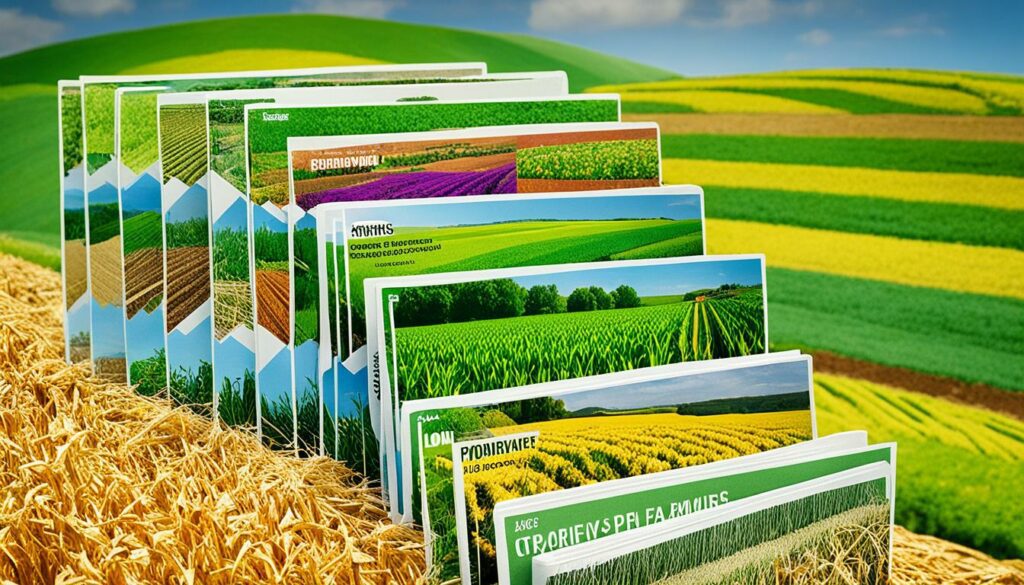
For daily farm expenses like livestock, equipment, and living costs, there are operating loans. They come at a 5.250% interest rate. These loans, up to $400,000, are great for keeping the farm running well. They focus on green farming too, showing USDA’s support for eco-friendly agriculture.
If you’re a small, new, or different kind of farmer, microloans might be perfect for you. The application is easy with less paperwork. These loans help with seeds, small farm upgrades or day-to-day costs. They encourage new ideas and make farming more open to everyone.
The USDA supports a variety of farms with its loan programs. It helps farming grow, stay green, and welcome new approaches.
| Loan Type | Interest Rate | Maximum Loan Amount | Special Features |
|---|---|---|---|
| Farm Ownership – Direct | 5.500% | $600,000 | Up to 100% financing |
| Farm Operating – Direct | 5.250% | $400,000 | Covers operational costs |
| Farm Ownership – Joint Finance | 3.500% | 50% of cost or value | FSA lends 50% of cost |
| Microloans | Varies | Varies | Reduced paperwork |
The USDA’s Agricultural Loan Programs help new farmers get a start and support those already farming. They aim to boost sustainable and efficient farming. This support is vital for the future of farming.
USDA’s loans are a big help for new farmers. The FSA sets aside funds each year for them. It’s for those who haven’t farmed much in the last ten years and own less than a third of the average county farm size.
In a place where farms average 94 acres, a new farmer needs less than 28.2 acres. Also, the FSA’s Down Payment Loans can cover up to 45% of a farm’s cost. You can get up to $300,150, needing only a 5% down payment.
Even those already in the field can get help from these loan programs. The FSA’s Direct Farm Ownership Loans go up to $600,000. They also offer a 50% joint financing plan.
There’s the Down Payment Loan too, which needs just a 5% down payment. It helps with up to 45% of the purchase price or appraised value, up to $667,000.
These loans come with good terms and rates to fit farm finances. Direct Farm Ownership Loans allow for up to a 40-year payback. The Down Payment Loans have a 20-year payment plan for the FSA’s part.
Farmers also get help from the FSA’s Loan Officers and Managers with the paperwork. This technical assistance is a significant support.
In short, USDA’s loans are key for both new and existing farm businesses. They ensure a bright future for agriculture.
The USDA’s loans play a key role in spreading climate-smart agriculture. These loans help farmers and ranchers upgrade their methods and gear. This boost efficiency and helps protect the environment.
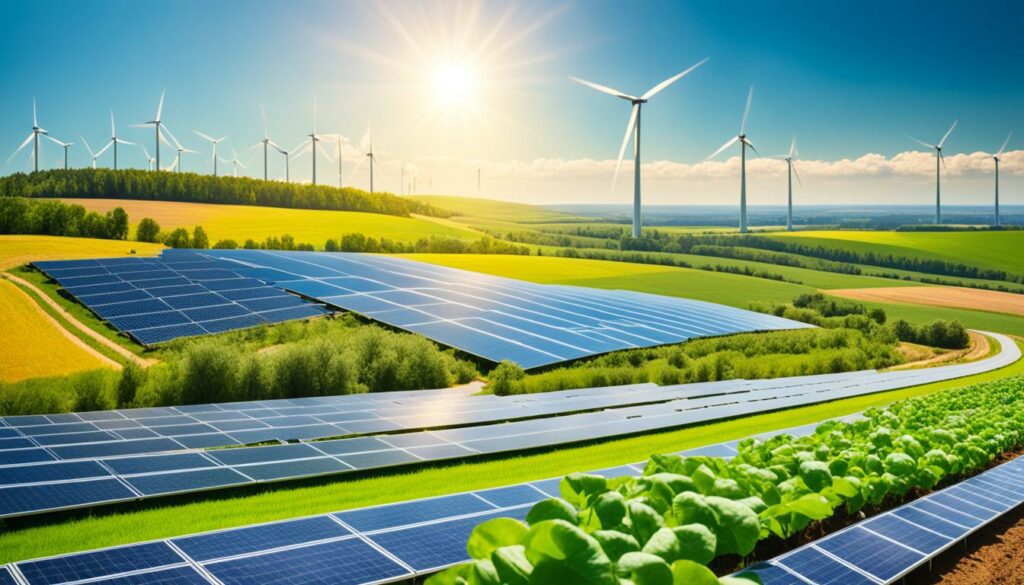
Precision agriculture relies on accurate data and modern tools. With USDA loans, farmers can get equipment like GPS tractors and smart sensors. These tools help them use resources wisely, leading to better crops, lower expenses, and less harm to the planet.
USDA loans are also big on conservation tillage. This method protects the soil, making it healthier and less likely to get eroded. Loans help get no-till or reduced-till gear. These steps improve soil quality, save on fuel, and cut down on greenhouse gases. In all, it makes farming more able to deal with extreme weather.
The USDA stands with farmers in the fight against climate change. Thanks to special loans like Farm Operating Loans and Farm Ownership Loans, up to $600,000, farmers can adopt these green farming methods more easily.
| Loan Type | Maximum Amount | Interest Rate | Terms |
|---|---|---|---|
| Farm Operating Loans | $400,000 | 5.250% | 1-7 years |
| Farm Ownership Loans | $600,000 | 5.500% | Up to 40 years |
| Emergency Loans | $500,000 | 3.750% | Contingent on disaster declarations |
| Microloans | $50,000 | Varies | Reduced paperwork |
Understanding the farm financing eligibility for USDA Agricultural Loans is important. These loans help U.S. farmers and ranchers with family farms. They may find it hard to get commercial credit. To apply, you must be a U.S. citizen or have legal resident status. You must not have had debt forgiven before.
To be eligible for agricultural credit qualification, the applicant must:
The Farm Service Agency (FSA) looks at more than just credit scores for agricultural credit qualification. They consider how well you’ve paid back debts and any special circumstances. This is a fairer way to assess farm financing eligibility.
There are three types of Direct Farm Ownership Loans: Regular, Joint Financing, and Down Payment Loans. Here is what each offers:
| Loan Type | Maximum Loan Amount | Maximum Repayment Period | Other Conditions |
|---|---|---|---|
| Regular Direct Farm Ownership Loan | $600,000 | 40 years | Must meet general eligibility requirements |
| Direct Farm Ownership Down Payment Loan | 45% of the purchase price (or appraised value) up to $667,000 | FSA portion: 20 years; Non-FSA portion: 30 years | 5% minimum down payment; must not own more than 30% of the average farm size in the county |
| Direct Farm Ownership Joint Financing Loan | Up to 50% of the property cost or value | 40 years | Compliant with FSA lending terms |
These loans support many farm needs. They help with buying new farms, expanding current ones, making down payments, and more. Special funds help beginning farmers every year, showing support for new entries in farming.
The USDA’s Farm Service Agency has made applying for agribusiness loans easier. They added tools and resources to help farmers apply for financial help. This makes the whole application process simple and smooth.
The USDA online loan tools are a big help. They let applicants find the best loans for them. There’s a tool to see what loans they can get and what they need. Farm Loan Officers are also there to help with filling forms and getting info for the loan.
Now, there’s an Online Loan Application too. It lets farmers apply without visiting in person. They can sign documents online and upload papers they need. This helps those with busy schedules. They can apply for agribusiness loans from home.

How loans are paid back is important too. The FSA has made it flexible for farmers, with up to 40 years for some loans. This means farmers can pay back the loan without stress. It’s a big help.
| Loan Type | Maximum Amount | Repayment Term |
|---|---|---|
| Direct Farm Ownership Loans | $600,000 | Up to 40 years |
| Beginning Farmer Down Payment | $300,150 | Up to 20 years |
| Down Payment Loans | 45% of purchase price or $667,000 | Up to 20 years |
In short, with easy applications, lots of help, and flexible repayment, USDA loans really support the farming world.
The USDA helps grow agriculture and make it sustainable. It does this through its many loan programmes. These programmes support rural areas and encourage eco-friendly farming.
The USDA aims to make life better for farmers and ranchers. It does this by offering different types of loans. The loans have good interest rates. For example:
These loans don’t just help farmers. They also boost the economy in rural areas. Some loan money is set aside for minority and women farmers. This helps them succeed.
The USDA supports eco-friendly farming methods. Farmers can use FSA loans for climate-smart practices. This includes buying precision farming tools, cover crops, and improving livestock facilities.
“Over 26,000 producers submit a Direct Loan application to FSA annually,” highlighting the extensive reach and impact of these loans.
The USDA also backs special programs like BCAP. It helps turn crops into bioenergy. The agency also supports things like putting air scrubbers in livestock buildings through loans.
The USDA makes getting loans easier. They offer an Online Loan Application with e-signature. There’s also a Loan Assistance Tool on farmers.gov. It helps applicants every step of the way. This shows the USDA’s focus on making sustainable farming more accessible.
USDA’s Agricultural Loans are crucial for achieving major environmental benefits of loans. They help farmers improve soil health and water management practices. This ensures that farming stays sustainable, which is key for the environment.
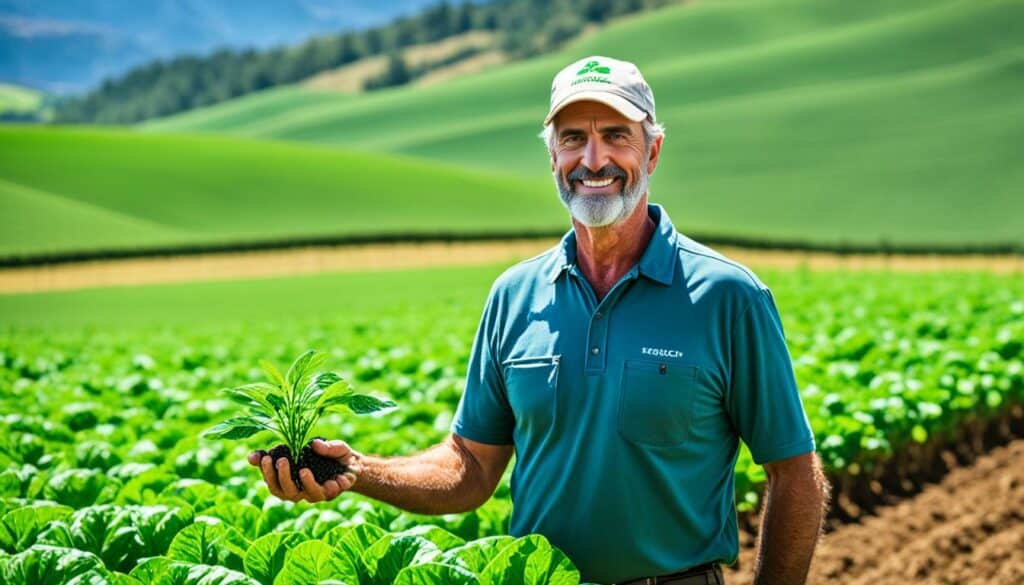
One big plus is the boost in soil health. The EQIP programme gives farmers both advice and cash to cut pollution from farms. It’s all about using nutrients better and looking after the soil. Farmers join EQIP through different schemes, like High Tunnel and Organic. These help in using smart methods to keep the soil well for the future.
The loans also help in managing water better. Part of the USDA’s loan funds go towards making water use smarter and saving more. This lets farmers cut down on water waste, ramp up how well they water plants, and use better water-save tech.
The NRCS keeps helping out with farm conservation, offering new chances for savings all the time. Group efforts by FSA, NRCS, RMA, and RD means all farmers, new and old, can learn the best ways to use water without harming the environment.
The U.S. Department of Agriculture (USDA) has specialised start-up farm loans for new farmers and ranchers. These loans help newcomers in farming get the money they need to start or grow their farms. They focus on beginning farmer finance, filling the gap between new farmers’ challenges and their success.
This support includes microloans, which are easier to get with less paperwork. They and other financing options aid new farmers in buying equipment and livestock. There are also youth loans for young people, ages 10 to 20, who want to start farming early.
For a detailed look at the interest rates and benefits of these loans, check out the table below:
| Loan Type | Interest Rate |
|---|---|
| Farm Operating – Direct | 5.250% |
| Farm Ownership – Direct | 5.500% |
| Farm Ownership – Direct, Joint Financing | 3.500% |
| Farm Ownership – Down Payment | 1.500% |
| Emergency Loan – Actual Loss | 3.750% |
The USDA’s Farm Service Agency (FSA) helps these new farmers adopt eco-friendly farming. This includes using Cover Crops and modern Precision Agriculture Equipment. FSA loans for eco-friendly farming gear show the USDA’s care for the environment and farming advancements.
The USDA also offers Loan Assistance Tools to make applying for loans easier. They provide clear info on loan types, what’s needed, and the forms necessary. Plus, applying online for these loans has become possible, making it easier and faster.
In conclusion, these specialised start-up farm loans and finance options are vital for new farmers and the future of farming. Offering easy terms, good rates, and help along the way, the USDA supports new farmers’ success in the challenging farm industry.
Agricultural loans from the USDA offer great benefits. They allow farmers to make important investments. These investments help the farm now and in the future. This way, farms can grow and work better over time.
Each year, more than 26,000 farmers ask the FSA for help in getting needed equipment. Farmers can get Term Operating Loans for smart farming tools and essential gear. This includes high-tech items like GPS globes and monitors. It also covers basic items such as strip till fertiliser gear.
These loans help cover the costs of seeds for cover crops. This ensures sustainable and productive farming.
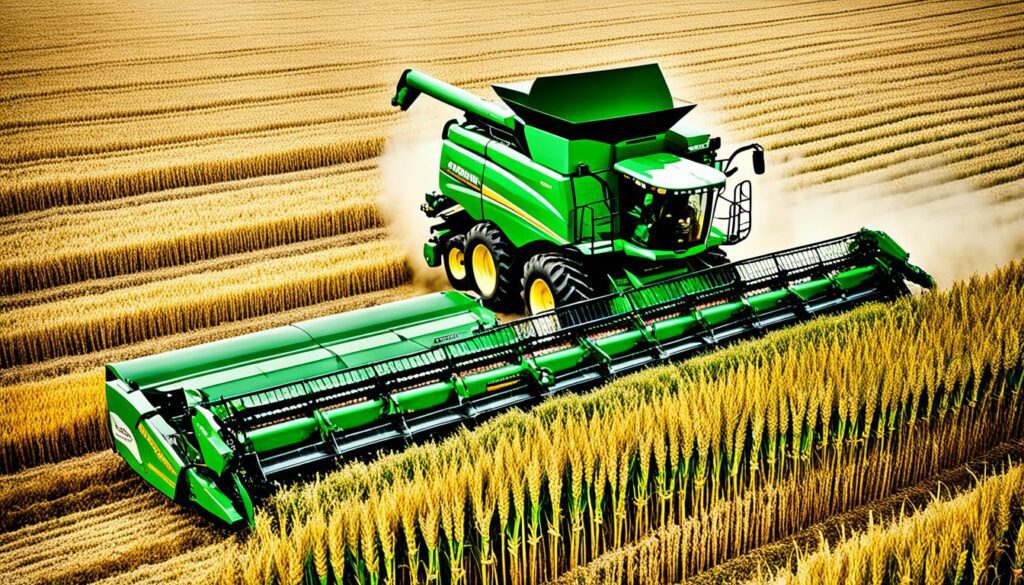
Expanding the farm is key for its growth. The USDA helps nearly 85,000 farmers with Direct Loans. This makes investing in farm growth projects easier.
These loans can support projects like setting up new grazing systems. Or they can help with putting up new fences. They also help improve livestock facilities with better air quality devices or waste systems.
Commodity loans have been key to U.S. farming since the 1930s, offering needed help with prices and income. The 2018 Agricultural Act made things better for the 2019-2023 growing seasons. It raised loan rates for certain crops. Farmers find help through Marketing Assistance Loans (MAL) and Loan Deficiency Payments (LDP).
Marketing Assistance Loans (MALs) give farmers money in advance for their crops. They act as a safety net price for various crops. With MALs, farmers can keep their harvested crops for up to nine months as they wait for better selling times. This system means farmers don’t have to sell low during bad market conditions.
This program is vital for keeping money flowing, especially when selling right away isn’t a good deal. By holding off on selling, farmers can wait for better prices to repay their loans. Usually, they pay back the loan plus interest. But, if market prices are lower than the loan rate, they pay back at the lower rate. This means they don’t have to pay the extra interest.
Loan Deficiency Payments (LDPs) are a different way to help farmers financially. They give money if a farmer doesn’t take an advance on their crops or chooses to wait for better market prices. This helps farmers not lose out on better prices. It means they can sell their crops when prices are high and keep the benefits.
Farmers can get these supports without their credit score being checked. It just depends on the quality of their crops and if they meet some rules. Farmers growing wheat, corn, soybeans, and more can use these aids. This lets them handle debt and buy vital farm tools. The loans have low interest rates, making it easier for farmers to invest and grow.
But, the help farmers get can change from place to place. This is due to different market prices and local situations. So, farmers should compare rates and choices to get the most from these loans.
The no down payment farm loans from the USDA are great for people wanting to buy a farm but don’t have much money at the start. They help first-time farmers and those with little cash. With no needed down payment, these loans make it simple to begin farming or grow a farm.
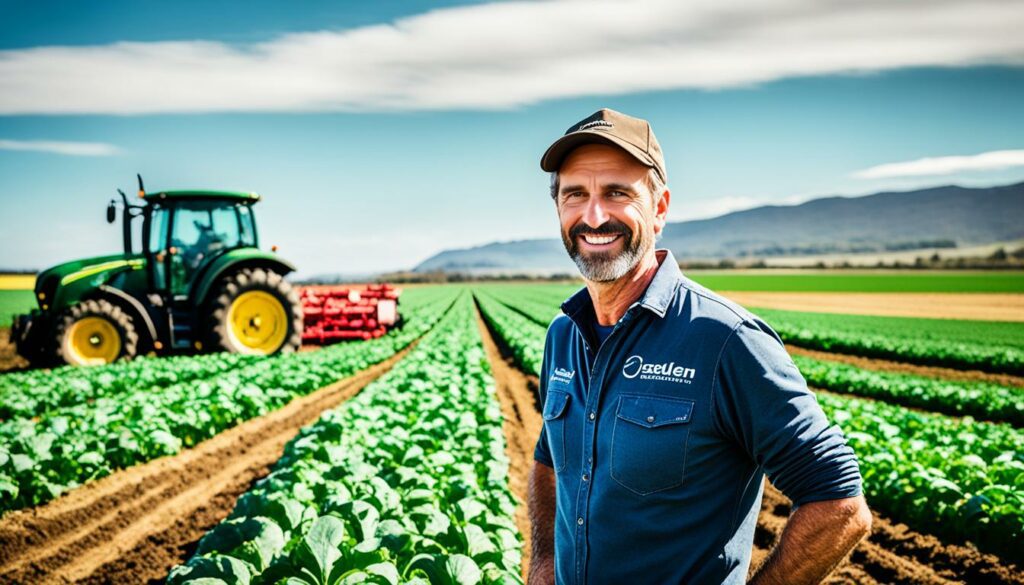
USDA loans come with low-interest rates because the U.S. Department of Agriculture supports them. They also don’t need a high credit score, just a FICO score of 640 or above. This is much better than regular land loans, which ask for a big down payment, making getting a loan without any money down very hard.
These loans don’t require Private Mortgage Insurance (PMI), which cuts down on monthly payments. You can pay back the loan early without any extra fees, which gives you more control over your finances. To be eligible, your household income should be less than 115% of the median for the area. Also, the property has to be in a rural area.
Here’s a comparison of key loan features:
| Feature | USDA Loans | Typical Land Loans |
|---|---|---|
| Down Payment | No Down Payment | 15-50% Down Payment |
| Private Mortgage Insurance | Not Required | Often Required |
| Credit Score Requirement | Around 640 | Varies by Lender |
| Prepayment Penalty | No Penalties | Varies |
In the end, the no down payment farm loans and other USDA mortgage advantages are a smart choice for farm buyers. They’re good for both new and experienced farmers, helping the agricultural sector in the U.S. grow.
USDA Agricultural Loan Programs have huge benefits. But, it’s vital to talk about their downsides. For example, there are income limits and property rules that may affect who can get these loans. Knowing about these limits helps farmers get ready for their applications.
One big issue with these loans is the income limits. They’re there to help those with real financial need. But, they might stop some farmers who earn a bit more from getting a loan. To apply, you need to show you can’t get a loan from other places. This rule aims to be fair, but it’s tough for those who have debts or big money problems.
Another key point is the rule on how much land you can own. If you’re new at farming, you shouldn’t own more than 30% of the average farm size in your county. This keeps the loans for new farmers and not those who already have a lot of land. However, this rule can make it hard for farmers to grow their businesses. Getting a Down Payment Loan has its own set of rules, making things even more complex.
Top of FormAlso, the USDA has special rules for which lands can get these loans. These rules depend on where your farm is. It’s crucial to check if your land fits these rules before you apply. Dealing with these rules needs careful planning and knowing all the rules. This helps you avoid problems and reach your farming goals.
These programs support farmers and ranchers financially. They can start, grow, or maintain their farms. Loans encourage new ways of farming that are better for the planet. This includes using energy better, managing water well, and helping the environment.
They also offer smaller loans for those who are new to farming. This makes it easier for them to get started.
The USDA has loans for different needs. Farm Ownership Loans help with buying or making farms bigger. Farm Operating Loans cover costs like animals and tools. Microloans are for smaller, new, or non-traditional farmers. These are easier to qualify for.
USDA loans help farmers use smarter farming methods. They fund new gear for precision farming, better ways to feed animals, and ways to protect the soil. These methods make farming more efficient and better for the environment.
To get these loans, you must run a family-sized farm. You’ll need to show your income and credit are okay. The loans help those who find it hard to get money from banks.
Applying for loans is easier now, thanks to the FSA. They have a tool to help find the right loan. And you can apply online, which saves time. You can also pay back the loan online, which is handy.
New farmers get big help from these loans. They make it easier to buy what’s needed to start farming. Microloans are a great option for new people. They give loans with easier-to-meet conditions.
The USDA’s job is to look after these loans. They aim to help rural areas, make farming better for the environment, and support growth in farming. They want to make sure farming is fair and safe for the planet.
Loans can make farms better for the soil. They fund things like cover crops that stop soil from washing away. This makes the soil healthier. They can also help farmers use water better, which is good for the planet.
Not needing a down payment makes it easier to buy a farm. This is very good for new farmers or those without much money. It gives more people the chance to make their farming dreams come true.
Yes, there are some things to keep in mind. There are limits on how much you can earn and where your farm can be. You also have to meet some rules. These might make it hard for some to get a loan.
Commodity loans help farmers when they need money most, like during harvest. They make up for low market prices. These loans and payments help keep farms financially safe and sound.